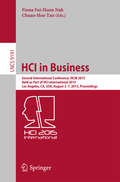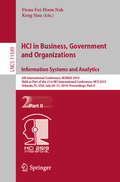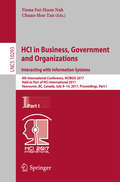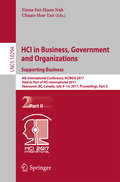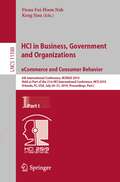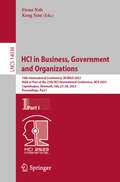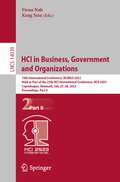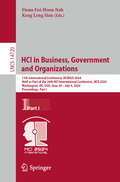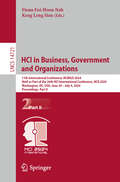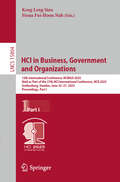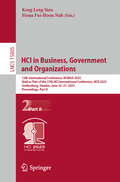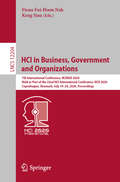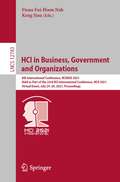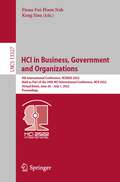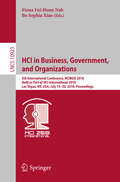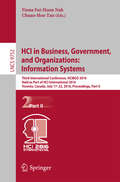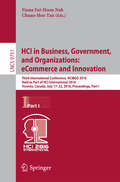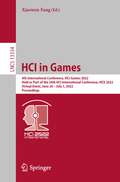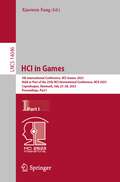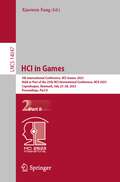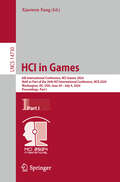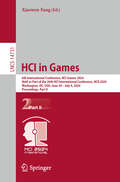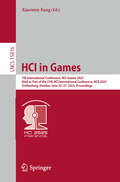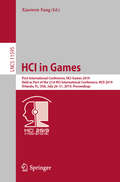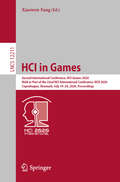- Table View
- List View
HCI in Business
by Fiona Fui-Hoon Nah Chuan-Hoo TanThis volume constitutes the refereed proceedings of the Second International Conference on HCI in Business, HCIB 2015, held as part of the 17th International Conference on Human-Computer Interaction, HCII 2015, which took place in Los Angeles, CA, USA, in August 2015. HCII 2015 received a total of 4843 submissions, of which 1462 papers and 246 posters were accepted for publication after a careful reviewing process. The papers address the latest research and development efforts and highlight the human aspects of design and use of computing systems. They thoroughly cover the entire field of human-computer interaction, addressing major advances in knowledge and effective use of computers in a variety of application areas. The 72 papers presented in this volume address the following topics: social media for business, enterprise systems, business and gamification, analytics, visualization and decision- making, industry, academia, innovation, and market.
HCI in Business, Government and Organizations. Information Systems and Analytics: 6th International Conference, HCIBGO 2019, Held as Part of the 21st HCI International Conference, HCII 2019, Orlando, FL, USA, July 26-31, 2019, Proceedings, Part II (Lecture Notes in Computer Science #11589)
by Fiona Fui-Hoon Nah Keng SiauThis two-volume set LNCS 11588 and 11589 constitutes the refereed proceedings of the 6th International Conference on Business, Government, and Organizations, HCIBGO 2019, held in July 2019 as part of HCI International 2019 in Orlando, FL, USA. HCII 2019 received a total of 5029 submissions, of which 1275 papers and 209 posters were accepted for publication after a careful reviewing process. The 63 papers presented in these two volumes are organized in topical sections named: Electronic, Mobile and Ubiquitous Commerce, eBanking and Digital Money, Consumer Behaviour, Business Information Systems, Dashboards and Visualization, Social Media and Big Data Analytics in B
HCI in Business, Government and Organizations. Interacting with Information Systems: 4th International Conference, HCIBGO 2017, Held as Part of HCI International 2017, Vancouver, BC, Canada, July 9-14, 2017, Proceedings, Part I (Lecture Notes in Computer Science #10293)
by Fiona Fui-Hoon Nah and Chuan-Hoo TanThis 2-volume set constitutes the refereed proceedings of the 4th International Conference on HCI in Business, Government and Organizations, HCIBGO 2017, held as part of the 19 International Conference on Human-Computer Interaction , HCII 2017, which took place in Vancouver, Canada, in July 2017. HCII 2017 received a total of 4340 submissions, of which 1228 papers were accepted for publication after a careful reviewing process. The 31 papers presented in this volume, focusing on interacting with information systems, are organized in topical sections named: human-centered design in information systems; information systems in healthcare, learning, cultural heritage and government; novel interaction devices and techniques;
HCI in Business, Government and Organizations. Supporting Business: 4th International Conference, HCIBGO 2017, Held as Part of HCI International 2017, Vancouver, BC, Canada, July 9-14, 2017, Proceedings, Part II (Lecture Notes in Computer Science #10294)
by Fiona Fui-Hoon Nah and Chuan-Hoo TanThis 2-volume set constitutes the refereed proceedings of the 4th International Conference on HCI in Business, Government and Organizations, HCIBGO 2017, held as part of the 19 International Conference on Human-Computer Interaction , HCII 2017, which took place in Vancouver, Canada, in July 2017. HCII 2017 received a total of 4340 submissions, of which 1228 papers were accepted for publication after a careful reviewing process. The 35 papers presented in this volume, focusing on supporting business, are organized in topical sections named: e-commerce and consumer behavior; social media for business; analytics, visualization and decision support.
HCI in Business, Government and Organizations. eCommerce and Consumer Behavior: 6th International Conference, HCIBGO 2019, Held as Part of the 21st HCI International Conference, HCII 2019, Orlando, FL, USA, July 26-31, 2019, Proceedings, Part I (Lecture Notes in Computer Science #11588)
by Fiona Fui-Hoon Nah Keng SiauThis two-volume set LNCS 11588 and 11589 constitutes the refereed proceedings of the 6th International Conference on Business, Government, and Organizations, HCIBGO 2019, held in July 2019 as part of HCI International 2019 in Orlando, FL, USA. HCII 2019 received a total of 5029 submissions, of which 1275 papers and 209 posters were accepted for publication after a careful reviewing process. The 63 papers presented in these two volumes are organized in topical sections named: Electronic, Mobile and Ubiquitous Commerce, eBanking and Digital Money, Consumer Behaviour, Business Information Systems, Dashboards and Visualization, Social Media and Big Data Analytics in B
HCI in Business, Government and Organizations: 10th International Conference, HCIBGO 2023, Held as Part of the 25th HCI International Conference, HCII 2023, Copenhagen, Denmark, July 23–28, 2023, Proceedings, Part I (Lecture Notes in Computer Science #14038)
by Keng Siau Fiona NahThis two-volume set of HCIBGO 2023, constitutes the refereed proceedings of the 10h International Conference on HCI in Business, Government and Organizations, held as Part of the 24th International Conference, HCI International 2023, which took place in July 2023 in Copenhagen, Denmark.The total of 1578 papers and 396 posters included in the HCII 2023 proceedings volumes was carefully reviewed and selected from 7472 submissions. The HCIBGO 2023 proceedings focuses in topics such as artificial intelligence and machine learning, blockchain, service design, live streaming in electronic commerce, visualization, and workplace design.
HCI in Business, Government and Organizations: 10th International Conference, HCIBGO 2023, Held as Part of the 25th HCI International Conference, HCII 2023, Copenhagen, Denmark, July 23–28, 2023, Proceedings, Part II (Lecture Notes in Computer Science #14039)
by Keng Siau Fiona NahThis two-volume set of HCIBGO 2023, constitutes the refereed proceedings of the 10h International Conference on HCI in Business, Government and Organizations, held as Part of the 24th International Conference, HCI International 2023, which took place in July 2023 in Copenhagen, Denmark.The total of 1578 papers and 396 posters included in the HCII 2023 proceedings volumes was carefully reviewed and selected from 7472 submissions. The HCIBGO 2023 proceedings focuses in topics such as artificial intelligence and machine learning, blockchain, service design, live streaming in electronic commerce, visualization, and workplace design.
HCI in Business, Government and Organizations: 11th International Conference, HCIBGO 2024, Held as Part of the 26th HCI International Conference, HCII 2024, Washington, DC, USA, June 29 – July 4, 2024, Proceedings, Part I (Lecture Notes in Computer Science #14720)
by Fiona Fui-Hoon Nah Keng Leng SiauThis two-volume set of HCIBGO 2024 constitutes the refereed proceedings of the 11h International Conference on HCI in Business, Government and Organizations, held as part of the 26th International Conference, HCI International 2024, which took place in from June 29 - July 4, 2024 in Washington DC, USA. Two volumes of the HCII 2024 proceedings are dedicated to this year’s edition of the HCIBGO conference. The first covers topics related to Digital Commerce and Marketing, Artificial Intelligence in Business, and Workplace, Well-being and Productivity. The second focuses on topics related to Teleworking and Virtual Collaboration, and Improving User Experience and Service Efficiency.
HCI in Business, Government and Organizations: 11th International Conference, HCIBGO 2024, Held as Part of the 26th HCI International Conference, HCII 2024, Washington, DC, USA, June 29 – July 4, 2024, Proceedings, Part II (Lecture Notes in Computer Science #14721)
by Fiona Fui-Hoon Nah Keng Leng SiauThis two-volume set of HCIBGO 2024 constitutes the refereed proceedings of the 11h International Conference on HCI in Business, Government and Organizations, held as part of the 26th International Conference, HCI International 2024, which took place in from June 29 - July 4, 2024 in Washington DC, USA. Two volumes of the HCII 2024 proceedings are dedicated to this year’s edition of the HCIBGO conference. The first covers topics related to Digital Commerce and Marketing, Artificial Intelligence in Business, and Workplace, Well-being and Productivity. The second focuses on topics related to Teleworking and Virtual Collaboration, and Improving User Experience and Service Efficiency.
HCI in Business, Government and Organizations: 12th International Conference, HCIBGO 2025, Held as Part of the 27th HCI International Conference, HCII 2025, Gothenburg, Sweden, June 22–27, 2025, Proceedings, Part I (Lecture Notes in Computer Science #15804)
by Fiona Fui-Hoon Nah Keng Leng SiauThis two-volume set of HCIBGO 2025 constitutes the refereed proceedings of the 12th International Conference on HCI in Business, Government and Organizations, held as part of the 27th International Conference, HCI International 2025, which took place in Gothenburg, Sweden, during June 22–27, 2025. Two volumes of the HCII 2025 proceedings are dedicated to this year&’s edition of the HCIBGO conference. The first volume covers topics related to User Experience, Design, and Digital Engagement; Artificial Intelligence in Digital Transformation and Business Processes; and Social Media and Market Insights. The second volume focuses on topics related to Roles, Skills, and Technology Adoption in Modern Workplaces; and Collaboration, Communication, and Work Dynamics.
HCI in Business, Government and Organizations: 12th International Conference, HCIBGO 2025, Held as Part of the 27th HCI International Conference, HCII 2025, Gothenburg, Sweden, June 22–27, 2025, Proceedings, Part II (Lecture Notes in Computer Science #15805)
by Fiona Fui-Hoon Nah Keng Leng SiauThis two-volume set of HCIBGO 2025 constitutes the refereed proceedings of the 12th International Conference on HCI in Business, Government and Organizations, held as part of the 27th International Conference, HCI International 2025, which took place in Gothenburg, Sweden, during June 22–27, 2025. Two volumes of the HCII 2025 proceedings are dedicated to this year&’s edition of the HCIBGO conference. The first volume covers topics related to User Experience, Design, and Digital Engagement; Artificial Intelligence in Digital Transformation and Business Processes; and Social Media and Market Insights. The second volume focuses on topics related to Roles, Skills, and Technology Adoption in Modern Workplaces; and Collaboration, Communication, and Work Dynamics.
HCI in Business, Government and Organizations: 7th International Conference, HCIBGO 2020, Held as Part of the 22nd HCI International Conference, HCII 2020, Copenhagen, Denmark, July 19–24, 2020, Proceedings (Lecture Notes in Computer Science #12204)
by Fiona Fui-Hoon Nah Keng SiauThis volume LNCS 12204 constitutes the refereed proceedings of the 7th International Conference on Business, Government, and Organizations, HCIBGO 2020, which was held in July 2020 as part of HCI International 2020 in Copenhagen, Denmark.* 1439 papers and 238 posters were accepted for publication after a careful reviewing process. The 42 papers presented in this volume are organized in topical sections named: digital transformation and intelligent data analysis and social media, digital commerce and marketing.*The conference was held virtually due to the COVID-19 pandemic. Chapter “The Effect of Queuing Technology on Customer Experience in Physical Retail Environments” is available open access under a Creative Commons Attribution 4.0 International License via link.springer.com.
HCI in Business, Government and Organizations: 8th International Conference, HCIBGO 2021, Held as Part of the 23rd HCI International Conference, HCII 2021, Virtual Event, July 24–29, 2021, Proceedings (Lecture Notes in Computer Science #12783)
by Fiona Fui-Hoon Nah Keng SiauThis book constitutes the refereed proceedings of the 8th International Conference on HCI in Business, Government and Organizations, HCIBGO 2021, which was held as part of HCI International 2021 and took place virtually during July 24-29, 2021.The total of 1276 papers and 241 posters included in the 39 HCII 2021 proceedings volumes was carefully reviewed and selected from 5222 submissions. The papers included in this book were organized in topical sections as follows: electronic, mobile and ubiquitous commerce; HCI in finance and industry; work and business operations; innovation, collaboration, and knowledge sharing; and digital transformation and artificial intelligence.
HCI in Business, Government and Organizations: 9th International Conference, HCIBGO 2022, Held as Part of the 24th HCI International Conference, HCII 2022, Virtual Event, June 26 – July 1, 2022, Proceedings (Lecture Notes in Computer Science #13327)
by Fiona Fui-Hoon Nah Keng SiauThis book constitutes the refereed proceedings of the 9th International Conference on HCI in Business, Government and Organizations, HCIBGO 2022, held as part of the 23rd International Conference, HCI International 2022, which was held virtually in June/July 2022. The total of 1271 papers and 275 posters included in the HCII 2022 proceedings was carefully reviewed and selected from 5487 submissions. The HCIBGO 2022 proceedings focuses in topics such as artificial intelligence and machine learning, blockchain, service design, live streaming in electronic commerce, visualization, and workplace design.
HCI in Business, Government, and Organizations: 5th International Conference, HCIBGO 2018, Held as Part of HCI International 2018, Las Vegas, NV, USA, July 15-20, 2018, Proceedings (Lecture Notes in Computer Science #10923)
by Fiona Fui-Hoon Nah Bo Sophia XiaoThis book constitutes the refereed proceedings of the 5th International Conference on HCI in Business, Government and Organizations, HCIBGO 2018, held as part of the 20th International Conference on Human-Computer Interaction, HCII 2018, in Las Vegas, NV, USA. The 1171 full papers and 160 posters presented at the 14 co-located HCII 2018 conferences were carefully reviewed and selected from a total of 4346 submissions. The papers address the latest research and development efforts and highlight the human aspects of design and use of computing systems. The papers thoroughly cover the entire field of human-computer interaction, addressing major advances in knowledge and effective use of computers in a variety of application areas. The papers included in this volume cover the following topics: information systems in business; electronic commerce and consumer behavior; social media and social communities in business; social innovation; and business analytics and visualization.
HCI in Business, Government, and Organizations: Information Systems
by Fiona Fui-Hoon Nah Chuan-Hoo TanThis volume constitutes the refereed proceedings of the Third International Conference on HCI in Business, Government and Organizations, HCIBGO 2016, held as part of the 18th International Conference on Human-Computer Interaction, HCII 2016, which took place in Toronto, Canada, in July 2016. HCII 2016 received a total of 4354 submissions, of which 1287 papers were accepted for publication after a careful reviewing process. The 43 papers presented in this volume were organized in topical sections named: designing information systems; HCI in the public administration and government; HCI at work; and mobile applications and services.
HCI in Business, Government, and Organizations: eCommerce and Innovation
by Fiona Fui-Hoon Nah Chuan-Hoo TanThis volume constitutes the refereed proceedings of the Third International Conference on HCI in Business, Government and Organizations, HCIBGO 2016, held as part of the 18th International Conference on Human-Computer Interaction, HCII 2016, which took place in Toronto, Canada, in July 2016. HCII 2016 received a total of 4354 submissions, of which 1287 papers were accepted for publication after a careful reviewing process. The 53 papers presented in this volume are organized in topical sections named: social media for business; electronic, mobile and ubiquitous commerce; business analytics and visualization; branding, marketing and consumer behavior; and digital innovation.
HCI in Games: 4th International Conference, HCI-Games 2022, Held as Part of the 24th HCI International Conference, HCII 2022, Virtual Event, June 26–July 1, 2022, Proceedings (Lecture Notes in Computer Science #13334)
by Xiaowen FangThis book constitutes the refereed proceedings of the 4th International Conference on HCI in Games, HCI in Games 2022, held as part of the 23rd International Conference, HCI International 2022, which was held virtually in June/July 2022. The total of 1271 papers and 275 posters included in the HCII 2022 proceedings was carefully reviewed and selected from 5487 submissions. The HCI in Games 2022 proceedings intends to help, promote and encourage research in this field by providing a forum for interaction and exchanges among researchers, academics, and practitioners in the fields of HCI and games. The Conference addresses HCI principles, methods and tools for better games.
HCI in Games: 5th International Conference, HCI-Games 2023, Held as Part of the 25th HCI International Conference, HCII 2023, Copenhagen, Denmark, July 23–28, 2023, Proceedings Part I (Lecture Notes in Computer Science #14046)
by Xiaowen FangThis two-volume set of HCI-Games 2023, constitutes the refereed proceedings of the 5th International Conference on HCI in Games, held as Part of the 24th International Conference, HCI International 2023, which took place in July 2023 in Copenhagen, Denmark.The total of 1578 papers and 396 posters included in the HCII 2023 proceedings volumes was carefully reviewed and selected from 7472 submissions. The HCI in Games 2023 proceedings intends to help, promote and encourage research in this field by providing a forum for interaction and exchanges among researchers, academics, and practitioners in the fields of HCI and games. The Conference addresses HCI principles, methods and tools for better games.
HCI in Games: 5th International Conference, HCI-Games 2023, Held as Part of the 25th HCI International Conference, HCII 2023, Copenhagen, Denmark, July 23–28, 2023, Proceedings, Part II (Lecture Notes in Computer Science #14047)
by Xiaowen FangThis two-volume set of HCI-Games 2023, constitutes the refereed proceedings of the 5th International Conference on HCI in Games, held as Part of the 24th International Conference, HCI International 2023, which took place in July 2023 in Copenhagen, Denmark.The total of 1578 papers and 396 posters included in the HCII 2023 proceedings volumes was carefully reviewed and selected from 7472 submissions. The HCI in Games 2023 proceedings intends to help, promote and encourage research in this field by providing a forum for interaction and exchanges among researchers, academics, and practitioners in the fields of HCI and games. The Conference addresses HCI principles, methods and tools for better games.
HCI in Games: 6th International Conference, HCI-Games 2024, Held as Part of the 26th HCI International Conference, HCII 2024, Washington, DC, USA, June 29–July 4, 2024, Proceedings, Part I (Lecture Notes in Computer Science #14730)
by Xiaowen FangThis book constitutes the refereed proceedings of the 6th International Conference on HCI in Games, held as part of the 26th International Conference, HCI International 2024, which took place in Washington DC, USA, during June 29 - July 4, 2024. The total of 1271 papers and 309 posters included in the HCII 2024 proceedings was carefully reviewed and selected from 5108 submissions. The two volume set of HCI-Games 2024 proceedings were organized in the following topical sections: Volume 14730: Part I: Game Design and Gamification; Part II: Game-based Learning; Part III: Games and Artificial Intelligence Volume 14731: Part I: Advancing Education Through Serious Games; Part II: Player Experience and Engagement
HCI in Games: 6th International Conference, HCI-Games 2024, Held as Part of the 26th HCI International Conference, HCII 2024, Washington, DC, USA, June 29–July 4, 2024, Proceedings, Part II (Lecture Notes in Computer Science #14731)
by Xiaowen FangThis book constitutes the refereed proceedings of the 6th International Conference on HCI in Games, held as part of the 26th International Conference, HCI International 2024, which took place in Washington DC, USA, during June 29 - July 4, 2024. The total of 1271 papers and 309 posters included in the HCII 2024 proceedings was carefully reviewed and selected from 5108 submissions. The two volume set of HCI-Games 2024 proceedings were organized in the following topical sections: Volume 14730: Part I: Game Design and Gamification; Part II: Game-based Learning; Part III: Games and Artificial Intelligence. Volume 14731: Part I: Advancing Education Through Serious Games; Part II: Player Experience and Engagement.
HCI in Games: 7th International Conference, HCI-Games 2025, Held as Part of the 27th HCI International Conference, HCII 2025, Gothenburg, Sweden, June 22–27, 2025, Proceedings (Lecture Notes in Computer Science #15816)
by Xiaowen FangThis book constitutes the refereed proceedings of the 7th International Conference on HCI in Games, held as part of the 27th International Conference, HCI International 2025, which took place in Gothenburg, Sweden, during June 22–27, 2025. The total of 1430 papers and 355 posters included in the HCII 2025 proceedings was carefully reviewed and selected from thousands of submissions. The HCI-Games 2025 proceedings was organized in the following topical sections: Part 1: Gamification, UX, and Player BehaviorPart 2: Identity, Emotion, and AI in Game ExperiencesPart 3: Gamified Learning and DesignPart 4: Games in Healthcare and Wellbeing
HCI in Games: First International Conference, HCI-Games 2019, Held as Part of the 21st HCI International Conference, HCII 2019, Orlando, FL, USA, July 26–31, 2019, Proceedings (Lecture Notes in Computer Science #11595)
by Xiaowen FangThis book constitutes the refereed proceedings of the First International Conference on HCI in Games, HCI-Games 2019, held in July 2019 as part of HCI International 2019 in Orlando, FL, USA. HCII 2019 received a total of 5029 submissions, of which 1275 papers and 209 posters were accepted for publication after a careful reviewing process. The 34 papers presented in this volume are organized in topical sections named: Game Design; Gaming Experience; Serious Games; and Gamification.
HCI in Games: Second International Conference, HCI-Games 2020, Held as Part of the 22nd HCI International Conference, HCII 2020, Copenhagen, Denmark, July 19–24, 2020, Proceedings (Lecture Notes in Computer Science #12211)
by Xiaowen FangThis book constitutes the refereed proceedings of the Second International Conference on HCI in Games, HCI-Games 2020, held in July 2020 as part of HCI International 2020 in Copenhagen, Denmark.* HCII 2020 received a total of 6326 submissions, of which 1439 papers and 238 posters were accepted for publication after a careful reviewing process. The 38 papers presented in this volume are organized in topical sections named: designing games and gamified interactions; user engagement and game impact; and serious games. *The conference was held virtually due to the COVID-19 pandemic.
